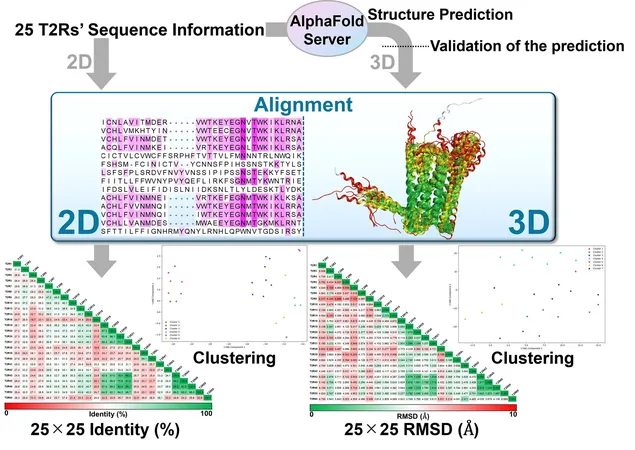
Unlocking the Mystery of Bitter Taste: AI Revolutionizes Protein Structure Analysis
2025-09-16
Author: Li
The Quest to Understand Bitter Taste Receptors
In a groundbreaking study, scientists have turned to artificial intelligence to decode the complex structures of bitter taste receptors, known as T2Rs, which could reshape our understanding of how we perceive taste.
Bitter Detection and the Gut-Brain Connection
Bitter taste receptors aren’t just located in our mouths; they're also found in the gastrointestinal tract, playing a pivotal role in sending signals from our gut to our brain. These discoveries suggest a vital link in the gut-brain axis, influencing everything from glucose tolerance to appetite regulation.
AI Models: A Game Changer in Protein Research
Previously, scientists relied on older AI models like AlphaFold2 to map these receptors. However, the introduction of the upgraded AlphaFold3 model offers unprecedented accuracy in predicting protein structures. This advancement forms the backbone of current research led by Professor Naomi Osakabe and her team.
Study Highlights: A Comparison of AI Models
The researchers compared predictions made by AlphaFold3 to those from AlphaFold2 and real-world structures of two specific T2Rs, T2R14 and T2R46. Their findings revealed that AlphaFold3 consistently outperformed its predecessor, aligning closely with experimental data and offering deeper insights into the receptors' structures.
Diving Deeper: Structural Similarities Among T2Rs
The study also looked at how these receptors are structured. Interestingly, while the intracellular components showed remarkable similarities, their extracellular regions were significantly more varied. This understanding could reveal why certain T2Rs react differently to various compounds.
Significance and Future Implications
Professor Osakabe emphasizes the importance of these findings in the context of health and pharmaceutical research. With bittersweet receptors potentially influencing lifestyle diseases like diabetes, unraveling their mysteries could lead to targeted treatments aimed at improving health outcomes.
Next Steps: Understanding Taste Perception
As researchers move forward, they will focus on the relationship between the sequence and structure of T2Rs. This comprehensive approach aims to unveil how individual variations in taste perception can affect our interactions with food and potentially lead to innovative health solutions.




 Brasil (PT)
Brasil (PT)
 Canada (EN)
Canada (EN)
 Chile (ES)
Chile (ES)
 Česko (CS)
Česko (CS)
 대한민국 (KO)
대한민국 (KO)
 España (ES)
España (ES)
 France (FR)
France (FR)
 Hong Kong (EN)
Hong Kong (EN)
 Italia (IT)
Italia (IT)
 日本 (JA)
日本 (JA)
 Magyarország (HU)
Magyarország (HU)
 Norge (NO)
Norge (NO)
 Polska (PL)
Polska (PL)
 Schweiz (DE)
Schweiz (DE)
 Singapore (EN)
Singapore (EN)
 Sverige (SV)
Sverige (SV)
 Suomi (FI)
Suomi (FI)
 Türkiye (TR)
Türkiye (TR)
 الإمارات العربية المتحدة (AR)
الإمارات العربية المتحدة (AR)